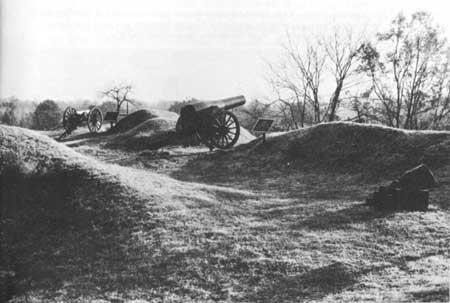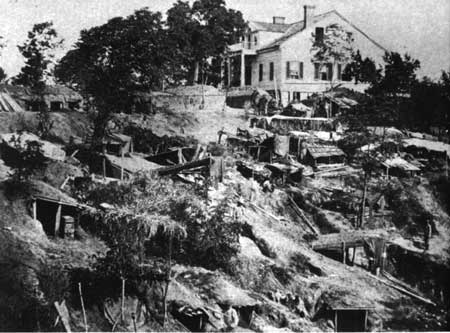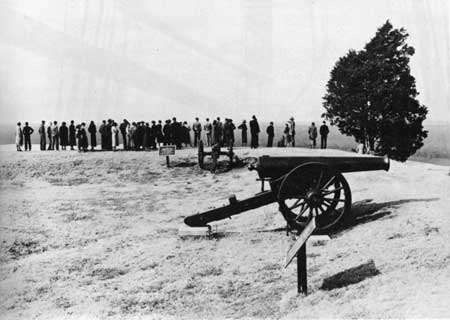|
VICKSBURG National Military Park |
 |

South Fort, on the Confederate right flank below Vicksburg,
overlooking the Mississippi.
The Siege of Vicksburg (continued)
CONFEDERATE TRENCH LIFE. Siege life for the Confederate soldier was a hazardous ordeal; nearly 3,500 were killed or wounded. Because of the limited number of effective troops available to Pemberton, almost the entire Vicksburg Army had to be placed in the trenches; sufficient numbers were not available to rotate frontline duty as was done by the Federal Army. Never knowing when an attempt might be made to assault the defense line, it was necessary for them to be on guard at all times, enduring sun, rain, mud, poor and inadequate food, as well as the bullets and shells of the Union Army for 47 days and nights. The unending barrage of small arms and artillery fire, one Confederate exclaimed, "can be compared to men clearing land—the report of musketry is like the chopping of axes and that of the cannon like the telling of trees."
Rations were generally prepared by details of soldiers behind the lines and carried to the troops at the breastworks. Coffee, the soldier's staple, was soon unobtainable and an ersatz beverage introduced, the somewhat questionable ingredients of which included sweet potatoes, blackberry leaves, and sassafras. To replace the exhausted flour supply, a substitute was devised from ground peas and cornmeal. When this was baked over a fire, one soldier complained, "it made a nauseous composition, as the corn-meal cooked in half the time the peas-meal did, so this stuff was half raw. . . . It had the properties of india-rubber and was worse than leather to digest." Its effect on the digestive systems of the Confederate soldiers was possibly the equivalent of a secret Yankee weapon. A more famous, although not necessarily a more palatable, item of the besieged soldiers' diet was the mule meat introduced late in the siege. General Pemberton heartily approved of its appearance, observing that mule proved "not only nutritious, but very palatable, in every way preferable to poor beef."

Bomb proofs of the 45th Illinois in Union siege
line. Shirley House in background is only surviving wartime building
in the park.
From Photographic History of the Civil War.
For protection against artillery fire, the Confederate troops dug bombproofs in the reverse slope of their fortified ridge. From these dugouts, bulwarked by heavy timbers, trenches connected with the fortifications, affording the besieged some degree of relaxation in reading or playing cards a few yards from the front line. To defend against surprise night attacks, they were forced to sleep on their arms in the trenches.
At night the unending bombardment from Porter's fleet provided the troops of both armies with an awesome pyrotechnic display. Especially popular with the pickets were the giant 13-inch mortar shells whose sputtering fuses described a tremendously high arc in the blackness before disappearing into the city. It was a "wonderful spectacle," one soldier remembered, "to see the fuse from the shells—and you could see them plainly—the comet or star-like streams of fire and then hear them coming down into the doomed city. We used to watch them while on picket at night."

Fort Hill, on the Confederate left flank above Vicksburg,
commanding the bend of the Mississippi.
Only when the Union trenches approached close to the defensive works were determined efforts made to halt the Union threat. Then the Union sap rollers (woven cane cylinders filled with earth or cotton rolled in front of the open end of the trench to protect the work party) became targets for destruction. Fuses were set on artillery shells which were then rolled down against the sap rollers, or they were ignited by Minie balls dipped in turpentine. Occasional night sallies succeeded temporarily in driving off Union work parties and filling up trenches, but no daylight forays were attempted by the Confederates.

|

| History | Links to the Past | National Park Service | Search | Contact |
|
Last Modified: Mon, Dec 2 2002 10:00:00 am PDT |

